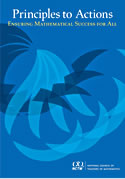
This book is a wonderful resource for educators wanting to learn more about mathematics education based on current educational research. One of the areas emphasized is "Facilitate Meaningful Mathematical Discourse". While the focus is on students, I have also used this idea to facilitate meaningful conversation among colleagues about our mathematics instruction. We had 20 classroom teachers attend an early morning "Math Summit" at our building in November. Out of the conversation, we identified retention of basic facts as a common source of frustration and a topic we wanted to explore further.
In December, we met again and sorted the standards for grades K-5 related to number sense, computation, and fluency. After discussion around the progression of learning across grade levels and observing that students should know from memory the basic facts for addition, subtraction, multiplication, and division by the end of grade 3, we read Gabriel T. Matney's article "Early Mathematics Fluency with CCSS-M". Currently, we are discussing in an on-line forum how we might define fluency and how we use number of the day, number talks, and problem solving to build fluency. Teachers are expanding their definition for fluency far beyond speed with recall of basic facts. We've had great discussions!
In Principles to Actions, there is a chart that describes the actions students are taking when participating in meaningful mathematical discourse. These include:
- Presenting and explaining ideas, reasoning, and representations to one another in pair, small-group, and whole-class discourse.
- Listening carefully to and critiquing the reasoning of peers, using examples to support or counterexamples to refute arguments.
- Seeking to understand the approaches used by peers by asking clarifying questions, trying out others' strategies, and describing the approaches used by others.
- Identifying how different approaches to solving a task are the same and how they are different.
No comments:
Post a Comment